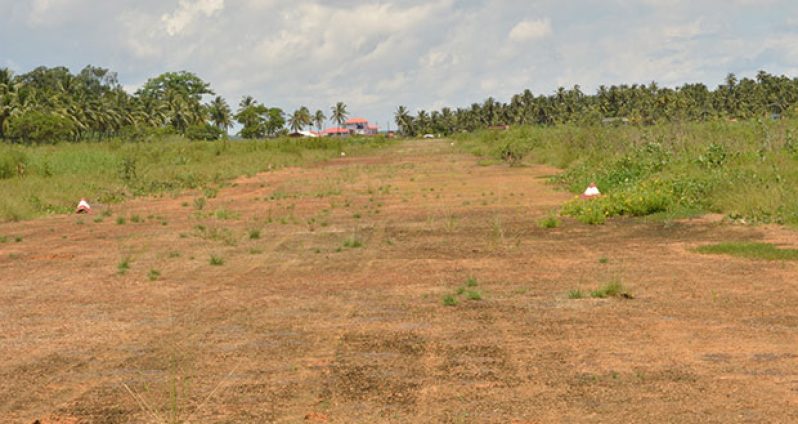By Tajeram Mohabir
IT IS very difficult to locate a private hire car at the Wakenaam Stelling; motorbikes appear to be the popular mode of transportation around this island of 17.5 square miles.A ride around the island without stopping would take about 50 minutes, but not stopping to make inquiries about villages where houses are very far apart would make the journey less interesting and incomplete.

My journey started at Sans Souci, the first village at the mouth of the island; and on the way, I noticed an abandoned structure which appeared to be a house. On asking, I leant that it was a plantain chip factory that was being constructed under the previous administration, but construction was halted when the new Government came to power.
Residents told the Guyana Chronicle that construction ceased for two main reasons:(1) The factory was close to the Government reserve, and (2) was vulnerable to flooding in event of a breach in the sea defence. Some disagreed with the last reason, pointing out that the nearby sea defence was fortified in recent years, and Government should revisit its decision to halt the project, since it would create employment for Wakenaam residents.
A simple inquiry from this newspaper appeared to have sparked a debate among residents, some of whom contended that much thought was not given to the project, and it would not be too helpful for local farmers.
Some farmers were of the view that the Parika plantain dealers would pay more for their plantains. They believe that once the factory sets a price, the Parika dealers would try to better it, and their produce would automatically go to the purchaser who was paying more. They opined that it would have been useful if the former Administration had consulted widely with the residents of Wakenaam before building the factory. They contend that the island does need a factory, but not for plantains alone; the vast amount of coconuts, mangoes and other fruits should also be given consideration.
On assumption to office, this Government had said it was unable to access the development plan for the plantain chip factories at Wakenaam and Leguan.

ENTERTAINMENT COMPLEX
Further up the main road and into the street stands a huge building; it is a private entertainment centre located next to a play field. This complex houses several buildings, works on which are still in progress. One huge three-storey building houses a hotel on the top flat, a banquet hall on the middle floor, and areas for stalls on the ground floor. Next to this building is a bar, and a short distance away is a modern, two-storey restaurant and bar, with a swimming pool on the ground floor.
This publication tried to contact the owner of the complex, but he was not home at the time.
And in the company of residents, I continued the journey where rice fields, coconut plantations and thick vegetation dominate the island’s landscape. At Maria’s Pleasure, I came across a neatly fenced, wide, abandoned land almost overrun by vegetation. On approaching the fence, a notice indicated that an airstrip was ahead. The compound was unguarded, and on entering, I saw a huge airstrip in a state of abandonment.
According to residents, the project was another poor investment made by the former administration. They told the Guyana Chronicle that, to the best of their knowledge, the multi-million-dollar airstrip was built several years ago, but was never put into operation.
Residents said they were told that the airstrip was supposed to reduce time and cost of transportation to and from the island; and by facilitating flights to hinterland regions, attract more investors to Wakenaam.
COLOSSAL JOKE
The latter never happened; and residents said they knew from the inception that, with speed boats around, it had to be a colossal joke to expect the airstrip to reduce transport costs to and from the island.
At Caledonia, the largest village on the island, I encountered a road in a deplorable state, and was about to turn around and head towards the rest house at Sans Souci when one of the residents indicated that a private investor had plans in train to build a resort at the beach at Moor Farm, facing the Atlantic Ocean. This project was never previously heard of, and after some hesitation, I decided to go visit the area where the resort was expected to be built. Intense rainfall had left the trail in such a muddy state that we could not help making heavy weather of the journey of just over a mile long.
At the beginning of the trail, some excavation work was noticeable, but this was done on less than 20 per cent of the entire trail. Residents told the Guyana Chronicle that excavation ended after the change in Government, and nothing more was heard about the investment.

We pressed on through the muddy, foot- wide tract in an area covered in dense vegetation with plantain suckers along the way, until we finally reached the shore line and were confronted with a breathtaking view of almond trees, compressed brown sand and the beautiful Atlantic Ocean.
The Guyana Chronicle was told that, from time to time, island residents would go to the isolated beach to engage in “bush cook” and enjoy the warm Atlantic breeze.
It was soon time to head out, and on the way to San Souci I came across a small village called Amersfort, which had a single house standing with no inhabitant. Residents reportedly abandoned the village in the late 1980s in search of a better standard of living.



.jpg)










